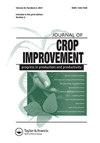Spatial models for seed yield, wilting, and maturity in furrow-irrigated soybean plots
IF 1
Q3 AGRONOMY
引用次数: 0
Abstract
ABSTRACT Field experiments are subjected to spatial variability due to factors such as soil moisture, fertility, pH, and structure, as well as the pressure of diseases and pests. Soybean yields are highly variable across fields. Controlling spatial variability could decrease the risk of erroneous inferences in breeding trials. This study aims at evaluating the spatial variability of furrow-irrigated soybean for seed yield, wilting, and maturity under four different irrigation levels. The field experiment was conducted in four environmzents (location-year combination). A total of 165 soybean lines of similar relative maturity (maturity group 5) along with commercial checks were planted in an augmented strip plot design. Irrigation treatment decisions were triggered using an atmometer based on a threshold at a designated growth stage. Data were analyzed via Analysis of Variance as a linear mixed model using a blocking structure (block model) and spatial covariances using range and column. Two different spatial models were used: exponential and Gaussian. Results showed that the spatial models displayed better data fitting (lower AIC and/or BIC) than the block model in each different irrigation level across different environments and traits. Indeed, genotype ranking for seed yield was different between the block model and the best spatial model, suggesting that spatial adjustment may be necessary for soybean breeding operations under furrow irrigation. Further validation in a breeding yield trial demonstrated similar results of the effectiveness in terms of AIC and/or BIC of the spatial model compared to the block model for soybean seed yield.沟灌大豆种子产量、枯萎和成熟度的空间模型
摘要田间试验受到土壤水分、肥力、pH值、结构以及病虫害压力等因素的空间变异性的影响。大豆产量在不同的田地之间变化很大。控制空间变异性可以降低育种试验中错误推断的风险。本研究旨在评估四种不同灌溉水平下沟灌大豆种子产量、枯萎和成熟度的空间变异性。野外试验在四个环境(地点-年份组合)中进行。共有165个具有相似相对成熟度的大豆品系(成熟度组5)以及商业检查在扩增条形地块设计中种植。灌溉处理决策是使用基于指定生长阶段阈值的大气湿度计触发的。数据通过方差分析作为线性混合模型使用块结构(块模型)进行分析,并使用范围和列进行空间协方差分析。使用了两种不同的空间模型:指数模型和高斯模型。结果表明,在不同环境和性状的每个不同灌溉水平下,空间模型比块体模型显示出更好的数据拟合(更低的AIC和/或BIC)。事实上,块区模型和最佳空间模型对种子产量的基因型排序不同,这表明在沟灌条件下,大豆育种操作可能需要进行空间调整。育种产量试验中的进一步验证表明,与大豆种子产量的块模型相比,空间模型在AIC和/或BIC方面的有效性结果相似。
本文章由计算机程序翻译,如有差异,请以英文原文为准。
求助全文
约1分钟内获得全文
求助全文
来源期刊

Journal of Crop Improvement
Multiple-
CiteScore
3.30
自引率
7.70%
发文量
42
期刊介绍:
Journal of Crop Science and Biotechnology (JCSB) is a peer-reviewed international journal published four times a year. JCSB publishes novel and advanced original research articles on topics related to the production science of field crops and resource plants, including cropping systems, sustainable agriculture, environmental change, post-harvest management, biodiversity, crop improvement, and recent advances in physiology and molecular biology. Also covered are related subjects in a wide range of sciences such as the ecological and physiological aspects of crop production and genetic, breeding, and biotechnological approaches for crop improvement.
 求助内容:
求助内容: 应助结果提醒方式:
应助结果提醒方式:


